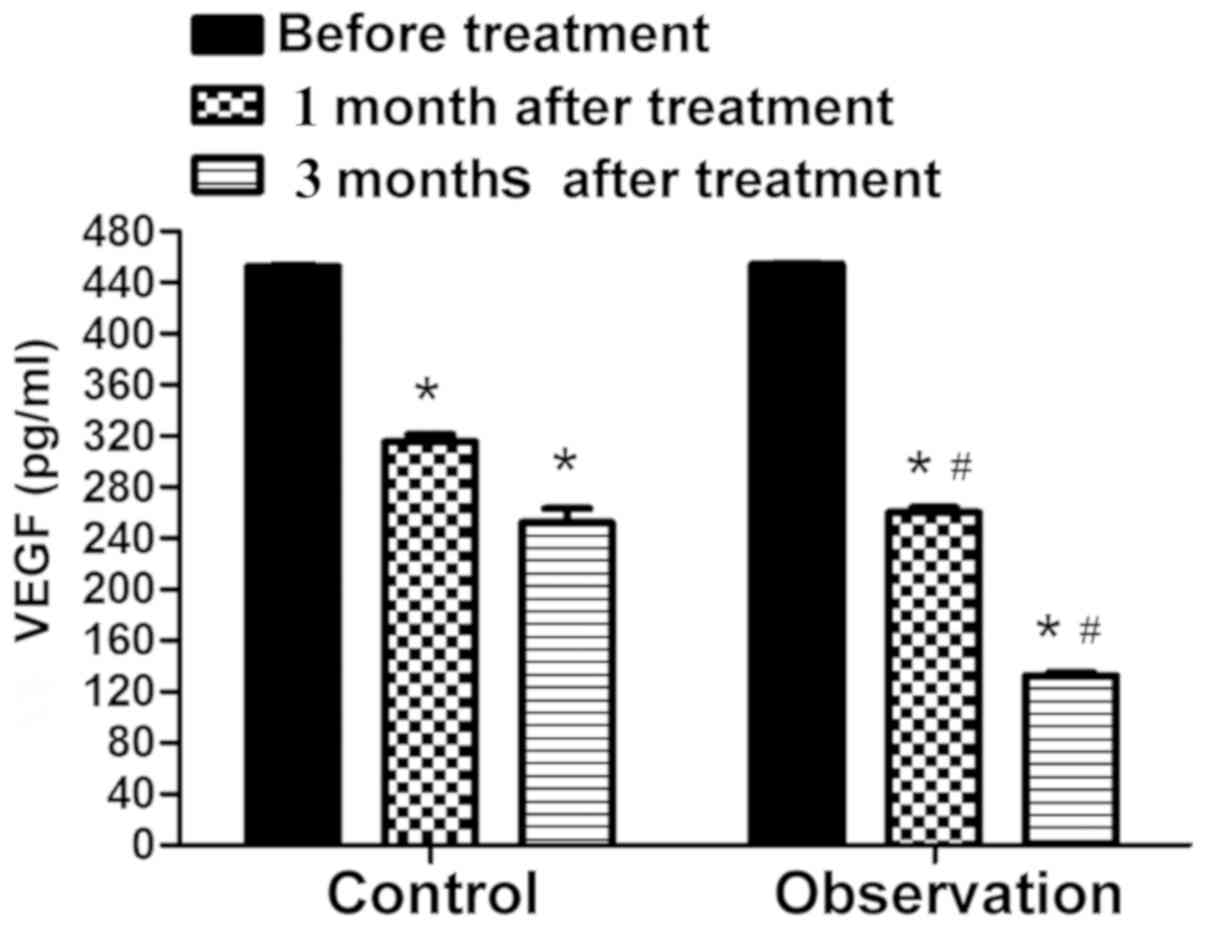|
1
|
Zhang HY, Ruan LB, Li Y, Yang TR, Liu WJ,
Jiang YX, Li TR, Quan J and Xuan W: ICOS/ICOSL upregulation
mediates inflammatory response and endothelial dysfunction in type
2 diabetes mellitus. Eur Rev Med Pharmacol Sci. 22:8898–8908.
2018.PubMed/NCBI View Article : Google Scholar
|
|
2
|
Sharma S, Oliver-Fernandez A, Liu W,
Buchholz P and Walt J: The impact of diabetic retinopathy on
health-related quality of life. Curr Opin Ophthalmol. 16:155–159.
2005.PubMed/NCBI View Article : Google Scholar
|
|
3
|
Zheng Y, He M and Congdon N: The worldwide
epidemic of diabetic retinopathy. Indian J Ophthalmol. 60:428–431.
2012.PubMed/NCBI View Article : Google Scholar
|
|
4
|
Fletcher EL, Phipps JA, Ward MM,
Puthussery T and Wilkinson-Berka JL: Neuronal and glial cell
abnormality as predictors of progression of diabetic retinopathy.
Curr Pharm Des. 13:2699–2712. 2007.PubMed/NCBI View Article : Google Scholar
|
|
5
|
Barber AJ: A new view of diabetic
retinopathy: A neurodegenerative disease of the eye. Prog
Neuropsychopharmacol Biol Psychiatry. 27:283–290. 2003.PubMed/NCBI View Article : Google Scholar
|
|
6
|
Antonetti DA, Barber AJ, Bronson SK,
Freeman WM, Gardner TW, Jefferson LS, Kester M, Kimball SR, Krady
JK, LaNoue KF, et al: JDRF Diabetic Retinopathy Center Group:
Diabetic retinopathy: Seeing beyond glucose-induced microvascular
disease. Diabetes. 55:2401–2411. 2006.PubMed/NCBI View Article : Google Scholar
|
|
7
|
Lieth E, Gardner TW, Barber AJ and
Antonetti DA: Penn State Retina Research Group: Retinal
neurodegeneration: Early pathology in diabetes. Clin Exp
Ophthalmol. 28:3–8. 2000.PubMed/NCBI View Article : Google Scholar
|
|
8
|
Pemp B, Garhofer G, Weigert G, Karl K,
Resch H, Wolzt M and Schmetterer L: Reduced retinal vessel response
to flicker stimulation but not to exogenous nitric oxide in type 1
diabetes. Invest Ophthalmol Vis Sci. 50:4029–4032. 2009.PubMed/NCBI View Article : Google Scholar
|
|
9
|
Luo D, Fan Y and Xu X: The effects of
aminoguanidine on retinopathy in STZ-induced diabetic rats. Bioorg
Med Chem Lett. 22:4386–4390. 2012.PubMed/NCBI View Article : Google Scholar
|
|
10
|
Mahmood D, Singh BK and Akhtar M: Diabetic
neuropathy: Therapies on the horizon. J Pharm Pharmacol.
61:1137–1145. 2009.PubMed/NCBI View Article : Google Scholar
|
|
11
|
Joussen AM, Doehmen S, Le ML Koizumi K,
Radetzky S, Krohne TU, Poulaki V, Semkova I and Kociok N: TNF-alpha
mediated apoptosis plays an important role in the development of
early diabetic retinopathy and long-term histopathological
alterations. Mol Vis. 15:1418–1428. 2009.PubMed/NCBI
|
|
12
|
Noor JI, Ikeda T, Mishima K, Aoo N, Ohta
S, Egashira N, Iwasaki K, Fujiwara M and Ikenoue T: Short-term
administration of a new free radical scavenger, edaravone, is more
effective than its long-term administration for the treatment of
neonatal hypoxic-ischemic encephalopathy. Stroke. 36:2468–2474.
2005.PubMed/NCBI View Article : Google Scholar
|
|
13
|
Bolton WK, Cattran DC, Williams ME, Adler
SG, Appel GB, Cartwright K, Foiles PG, Freedman BI, Raskin P,
Ratner RE, et al: ACTION I Investigator Group: Randomized trial of
an inhibitor of formation of advanced glycation end products in
diabetic nephropathy. Am J Nephrol. 24:32–40. 2004.PubMed/NCBI View Article : Google Scholar
|
|
14
|
Eldred WD and Blute TA: Imaging of nitric
oxide in the retina. Vision Res. 45:3469–3486. 2005.PubMed/NCBI View Article : Google Scholar
|
|
15
|
Jonas JB, Kreissig I, Söfker A and
Degenring RF: Intravitreal injection of triamcinolone for diffuse
diabetic macular edema. Arch Ophthalmol. 121:57–61. 2003.PubMed/NCBI View Article : Google Scholar
|
|
16
|
Jakus V and Rietbrock N: Advanced
glycation end-products and the progress of diabetic vascular
complications. Physiol Res. 53:131–142. 2004.PubMed/NCBI
|
|
17
|
Qazi Y, Maddula S and Ambati BK: Mediators
of ocular angiogenesis. J Genet. 88:495–515. 2009.PubMed/NCBI View Article : Google Scholar
|
|
18
|
Li ZP, Xu X, Huang YF, Zhu JF, Wang XJ, Hu
HH and He ZP: Exogenous advanced glycosylation end products induce
diabetes-like vascular dysfunction in normal rats: A factor for
occurrence of diabetic retinopathy. Zhonghua Yan Ke Za Zhi.
39:352–356. 2003.(In Chinese). PubMed/NCBI
|
|
19
|
Yin Y, Chen F, Wang W, Wang H and Zhang X:
Resolvin D1 inhibits inflammatory response in STZ-induced diabetic
retinopathy rats: Possible involvement of NLRP3 inflammasome and
NF-κB signaling pathway. Mol Vis. 23:242–250. 2017.PubMed/NCBI
|
|
20
|
Mishra A and Newman EA: Aminoguanidine
reverses the loss of functional hyperemia in a rat model of
diabetic retinopathy. Front Neuroenergetics. 3(10)2012.PubMed/NCBI View Article : Google Scholar
|
|
21
|
Sun W, Yu WY, Yu DJ, Zhao TL, Wu LJ and
Han WY: The effects of recombinant human growth hormone (rHGH) on
survival of slender narrow pedicle flap and expressions of vascular
endothelial growth factor (VEGF) and classification determinant 34
(CD34). Eur Rev Med Pharmacol Sci. 22:771–777. 2018.PubMed/NCBI View Article : Google Scholar
|
|
22
|
Lenz T, Haak T, Malek J, Gröne HJ, Geiger
H and Gossmann J: Vascular endothelial growth factor in diabetic
nephropathy. Kidney Blood Press Res. 26:338–343. 2003.PubMed/NCBI View Article : Google Scholar
|
|
23
|
Mehta H, Gillies MC and Fraser-Bell S:
Combination of vascular endothelial growth factor inhibitors and
laser therapy for diabetic macular oedema: A review. Clin Exp
Ophthalmol. 44:335–339. 2016.PubMed/NCBI View Article : Google Scholar
|
|
24
|
Riches K, Franklin L, Maqbool A, Peckham
M, Adams M, Bond J, Warburton P, Feric NT, Koschinsky ML, O'Regan
DJ, et al: Apolipoprotein(a) acts as a chemorepellent to human
vascular smooth muscle cells via integrin αVβ3 and RhoA/ROCK-
mediated mechanisms. Int J Biochem Cell Biol. 45:1776–1783.
2013.PubMed/NCBI View Article : Google Scholar
|
|
25
|
Arden GB and Sivaprasad S: The
pathogenesis of early retinal changes of diabetic retinopathy. Doc
Ophthalmol. 124:15–26. 2012.PubMed/NCBI View Article : Google Scholar
|
|
26
|
Giove TJ, Deshpande MM, Gagen CS and
Eldred WD: Increased neuronal nitric oxide synthase activity in
retinal neurons in early diabetic retinopathy. Mol Vis.
15:2249–2258. 2009.PubMed/NCBI
|















